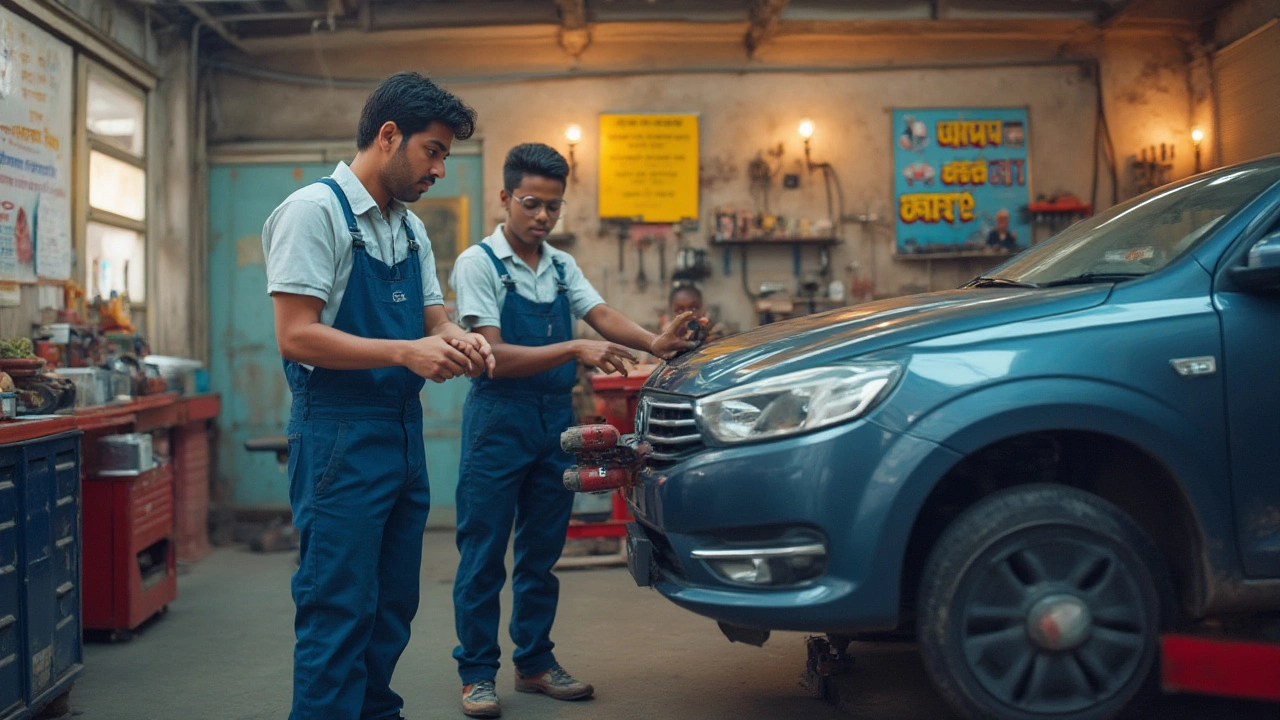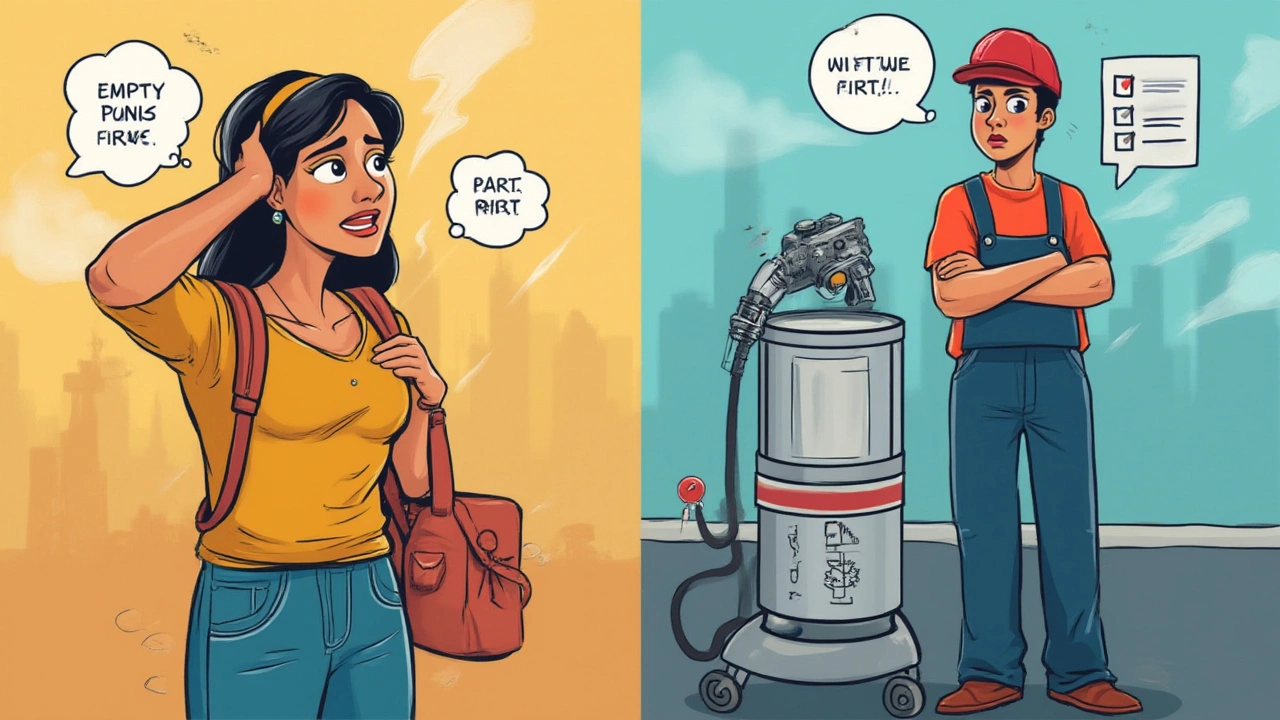 Jul, 30 2025
Jul, 30 2025
There’s something both nerve-wracking and weirdly satisfying about taking on a fuel pump replacement in your own garage. The idea: slice hours off the mechanic’s bill and keep your family wheels running strong. But right out of the gate, you do a quick search and stumble into a split world—some say you have to drain the tank bone-dry before you start. Others say, “Don’t bother.” So which is it? Let’s rip into the real facts about swapping out a fuel pump; you might be surprised by what actually matters and what’s just another old garage tale.
Why the "Empty Tank" Advice Exists
If you grew up passing wrenches to your dad—or got thrown into emergency car repairs after your first engine light—chances are someone drilled it into you: “Drain that tank first or you’ll regret it.” Why does this advice stick around?
It actually comes down to three things: mess, safety, and access. Older cars (think early 2000s and before) often have external or underbody pumps. Replacing those usually means dropping the whole tank—a full one weighs way more than you expect. Even a plastic 16-gallon tank pushes 100 pounds once you account for the weight of gasoline. And unless you’re part ox, wresting that out from under the car is a recipe for bad backs and spilled fuel.
Then there’s the fire risk. Gasoline is, by every scientific standard, a ridiculously flammable liquid. Vapors can ignite from a single spark. Anyone lifting a heavy tank full of sloshing fuel near their face and power tools is playing with danger. I still remember a guy in my hometown who forgot to disconnect the battery while changing a pump; the flash-fire left scars (and a burning caution into the local rumor mill).
But modern cars? They’ve changed the game. More and more vehicles now mount the pump inside the tank, but make it accessible through a service port beneath the back seat or trunk. Suddenly, the so-called need for an empty tank isn’t about safety or muscle—it's about convenience and keeping things clean.
| Year | Common Fuel Pump Location | Empty Tank Required? |
|---|---|---|
| Pre-2000 | External/Underbody | Recommended |
| 2000-2010 | Mainly In-Tank, No Service Port | Usually Yes |
| 2010+ (Most Cars) | In-Tank with Service Port | Not Necessary |
When an Empty Tank Is Actually Needed
All right—so not everyone needs to drain their tank. But sometimes you do. If you drive a truck, van, or a car that still hides the fuel pump above or inside the tank shell, you’re looking at a drop-the-tank job. Here’s where the wisdom comes in: gasoline weighs nearly 6.3 lbs per gallon, and a modern tank can hold up to 20 gallons. Shoving a 120-pound, fuel-filled tank off its hangers from beneath the car is a nightmare (and borderline dangerous).
You’ll want to siphon out as much fuel as possible, ideally using a hand pump, or if you’re especially old school, a length of hose and a big gas can on the floor. A quick note—don’t try to tip the car on an incline to drain the last drops, unless you’re itching for trouble. It's way easier to run the car as close to empty as your nerves can handle before diving in.
But what about the flip side? If your vehicle has an in-tank pump you can reach under the rear seat or from the trunk, it’s honestly fine to leave in a few (or even several) gallons of fuel. Most of the time, you’re just removing a ring, lifting out the fuel assembly, and popping in the new one. The only real mess is whatever sloshes out as you lift the pump. Pros suggest laying down plenty of towels and even plastic sheets to contain any spills—a tip I learned the hard way after trying to impress Archer with “dad’s cool fix.” We ended up cleaning sticky gasoline off the seatbelts for a week.
Another curveball: factory service manuals from brands like Ford, Toyota, and Honda no longer list an empty tank as a requirement when using a service port—just “as low as practical.” Why do they hedge their bets? Less fuel means fewer spills. But it also means less vapor in the tank, which is important if you’re working inside a closed garage, especially in July. Gasoline vapor hovers—and unless you’ve got a garage fan or the doors open wide, breathing those fumes risks a brutal headache.

How to Safely Change the Fuel Pump
Let’s break it down—step by step, no nonsense. Whether your tank is nearly empty or sitting at a quarter, there are tricks to make life easier. The golden rule: disconnect the battery first. Every mechanic who’s ever zapped themselves messing with a fuel line will back me up here. Modern cars carry current everywhere, and the last thing you want is juice arcing while you’re elbow-deep in gasoline.
- Relieve the fuel system pressure. Pick up the owner’s manual and pull the fuel pump fuse or relay—then crank the engine until it stalls. This stops fuel from spraying the moment you loosen a fitting.
- Ventilate the area. Don’t work in a closed garage unless you hate headaches. Prop the doors, run a fan. Gasoline vapor is heavier than air and likes to pool at your ankles.
- Have a fire extinguisher nearby—and one rated for flammable liquids. A kitchen extinguisher won't cut it. Don’t let your kids, pets, or anyone with a cigarette within a mile.
- If dropping the tank, siphon out gasoline using a dedicated fuel pump. Don’t suck on hoses—seriously, people still end up with gas in their mouths (and it’s both toxic and gross).
- If using a service port, work systematically. Disconnect lines and electrical harnesses first. Use pliers to knock loose the lock ring, then lift out the pump. Watch for fuel drips—some DIYers swear by shop vacs, but that’s a big no. Static inside the vac can ignite fumes.
- Install the new pump, double-check the O-ring for a good seal, and reverse your steps. Don’t reuse old clamps or gaskets—they break the first time you hit a speed bump.
Sometimes you’ll find rust or gunk clogging the opening. Take this chance to peer into the tank with a flashlight (not a lighter!) and wipe out crud you see on the rim. It’s amazing how many “failed” new pumps actually die from junk sucked off the tank walls right after a swap.
Common Myths (and Why They Won’t Die)
Let’s bust a few myths. First, the “always empty” rule is just outdated. It's based on old school underbody pumps. New in-tank setups and service ports changed the game. Leaving a couple gallons in is almost always safe if you mind spills and ventilate. The second myth—running your tank close to empty starves the new pump. That's not true unless you habitually run on fumes. Modern returnless systems can handle a low tank for the swap. Just don’t leave the ignition on without fuel a long time, and you’re golden.
Another one that’s everywhere: new pumps always need a new filter. True for many vehicles, false for others. Some kits include two pieces, some only the pump itself. Check your model—some fuel filters are actually inside the pump assembly. Swap both if you can. If the manual lists separate filters, don’t try to save $10—the new pump will thank you in the end.
And then there’s the ever-popular “fuel stabilizer is required if you don’t empty the tank.” That’s only needed if the car sits unused for months. If you're swapping the pump and hitting the road soon, you can skip the chemicals.
Pro tip for the truly cautious: after the new pump is in, cycle the key a few times before cranking the engine. This primes the system so the first startup’s smooth. If you just ram the starter right away, you might get a longer crank and wonder if something’s wrong.

Tips for a No-Regrets Fuel Pump Swap
Here’s how to actually make this job less painful than your kid’s last science fair. Start the project with the tank as low as you can manage—below 1/4 is ideal. That cuts spills, reduces weight, and keeps the mess minimal. Prep with shop rags, gloves, and consider a cheap plastic drop cloth if you're accessing through the interior. Have the new pump and all new washers, seals, and clamps ready—waiting on a $2 clamp from the parts store mid-job will crash your whole Saturday.
Most everyday cars (think Camry, Accord, F-150 post-2015) let you access the pump without draining the tank. For trucks or older sedans, draining most of the gasoline is a must, unless you're the Incredible Hulk. If you get stuck trying to loosen rusted tank straps or unyielding lock rings, mix in a dash of penetrating oil and patience—don’t beat on things or you’ll dent the tank. And always—always—double check everything is reconnected before you start the car. Mess this up and the "check engine" light will return quicker than your last birthday.
If you’ve got kids around, they’ll get endless amusement from the “bad-smelling juice” dad is fussing over. But keep little hands far back—gasoline is both toxic and stings like crazy if it touches skin. Used gloves, clean clothes, and lots of ventilation make a big difference.
And for fun—did you know the average American changes their fuel pump only once every 8 to 10 years? That’s about 120,000 to 150,000 miles, depending on your luck and how much ethanol is in your local gas. Cheap pumps fail earlier, so don't skimp for whatever’s cheapest online—you’ll end up doing this again before you’re ready.
The takeaway? Unless your car demands the tank be dropped, you don’t need to drain it dry—just go as low as you comfortably can. Watch for sparks, vent the area, and have a backup plan for gas spills. Then get ready for that sweet, anxiety-cutting first ignition with a fresh fuel pump and the confidence of a job well done.